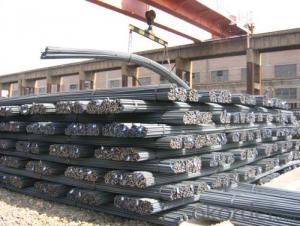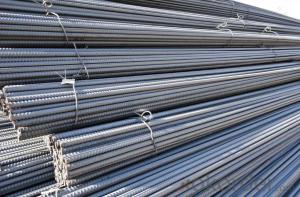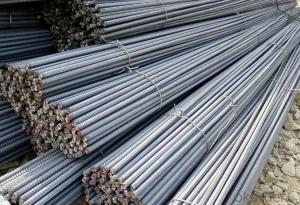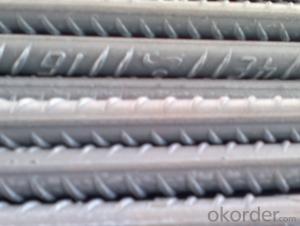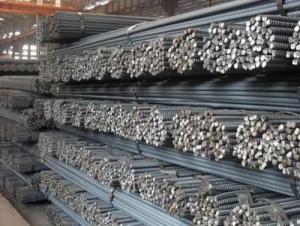Deformed bars in Grade HRB400/500 with Best Quality
- Loading Port:
- Tianjin
- Payment Terms:
- TT OR LC
- Min Order Qty:
- 25 m.t.
- Supply Capability:
- 100000 m.t./month
OKorder Service Pledge
OKorder Financial Service
You Might Also Like
Product Description:
Specifications of HRB400 Deformed Steel Bar:
Standard | GB | HRB400 | |
Diameter | 6mm,8mm,10mm,12mm,14mm,16mm,18mm,20mm, 22mm,25mm,28mm,32mm,36mm,40mm,50mm | ||
Length | 6M, 9M,12M or as required | ||
Place of origin | Hebei, China mainland | ||
Advantages | exact size, regular package, chemical and mechanical properties are stable. | ||
Type | Hot rolled deformed steel bar | ||
Brand name | DRAGON | ||
Chemical Composition: (Please kindly find our chemistry of our material based on HRB500 as below for your information)
Grade | Technical data of the original chemical composition (%) | ||||||
C | Mn | Si | S | P | V | ||
HRB400 | ≤0.25 | ≤1.60 | ≤0.80 | ≤0.045 | ≤0.045 | 0.04-0.12 | |
Physical capability | |||||||
Yield Strength (N/cm²) | Tensile Strength (N/cm²) | Elongation (%) | |||||
≥400 | ≥570 | ≥14 | |||||
Theoretical weight and section area of each diameter as below for your information:
Diameter(mm) | Section area (mm²) | Mass(kg/m) | Weight of 12m bar(kg) |
6 | 28.27 | 0.222 | 2.664 |
8 | 50.27 | 0.395 | 4.74 |
10 | 78.54 | 0.617 | 7.404 |
12 | 113.1 | 0.888 | 10.656 |
14 | 153.9 | 1.21 | 14.52 |
16 | 201.1 | 1.58 | 18.96 |
18 | 254.5 | 2.00 | 24 |
20 | 314.2 | 2.47 | 29.64 |
22 | 380.1 | 2.98 | 35.76 |
25 | 490.9 | 3.85 | 46.2 |
28 | 615.8 | 4.83 | 57.96 |
32 | 804.2 | 6.31 | 75.72 |
36 | 1018 | 7.99 | 98.88 |
40 | 1257 | 9.87 | 118.44 |
50 | 1964 | 15.42 | 185.04 |
Usage and Applications of HRB400 Deformed Steel Bar:
Deformed bar is widely used in buildings, bridges, roads and other engineering construction. Big to highways, railways, bridges, culverts, tunnels, public facilities such as flood control, dam, small to housing construction, beam, column, wall and the foundation of the plate, deformed bar is an integral structure material. With the development of world economy and the vigorous development of infrastructure construction, real estate, the demand for deformed bar will be larger and larger..
Packaging & Delivery of HRB400 Deformed Steel Bar:
Packaging Detail: products are packed in bundle and then shipped by container or bulk vessel, deformed bar is usually naked strapping delivery, when storing, please pay attention to moisture proof. The performance of rust will produce adverse effect.
Each bundle weight: 2-3MT, or as required
Payment term: TT or L/C
Delivery Detail: within 45 days after received advanced payment or LC.
Label: to be specified by customer, generally, each bundle has 1-2 labels
Trade terms: FOB, CFR, CIF
- Q:Can steel rebars be used in structures with high carbonation levels in concrete?
- Using steel rebars in structures with high carbonation levels in concrete is not advisable. Carbonation is a chemical reaction that occurs when carbon dioxide reacts with the alkaline components present in concrete. This reaction leads to a decrease in the alkalinity of the concrete, which can result in the dissolution of the protective layer surrounding the steel rebars. Consequently, the steel becomes exposed to corrosion, ultimately weakening the structure over time. To minimize the risk of corrosion, it is recommended to employ alternative materials such as stainless steel rebars in structures with high carbonation levels. Stainless steel rebars exhibit superior resistance to corrosion compared to carbon steel rebars, enabling them to withstand the harsh environment created by elevated carbonation levels in concrete. Furthermore, it is advisable to consider additional corrosion protection measures, including epoxy coating or increased concrete cover thickness, to further enhance the structure's durability and longevity.
- Q:How do steel rebars affect the overall sound insulation of a building?
- Steel rebars have minimal impact on the overall sound insulation of a building. While they may conduct sound to a small extent due to their rigid nature, the primary factors affecting sound insulation are the materials used for walls, floors, and ceilings, as well as insulation materials. Steel rebars are typically embedded within concrete structures and do not significantly contribute to sound transmission between spaces.
- Q:How are steel rebars connected to each other during construction?
- Steel rebars are connected to each other during construction using various methods such as overlapping, welding, or mechanical couplers.
- Q:Can steel rebars be used in residential foundation construction?
- Indeed, residential foundation construction can incorporate steel rebars. These rebars are widely utilized in reinforced concrete structures, including residential foundations, with the intention of bolstering their robustness and longevity. To reinforce and avert cracking or structural collapse, the rebars are typically positioned in a grid formation throughout the foundation. They play a crucial role in evenly distributing the building's load and enhancing its ability to withstand diverse forces, such as soil pressure, wind, and seismic activity. Furthermore, steel rebars possess corrosion resistance and are capable of enduring severe weather conditions, thereby rendering them a dependable option for residential foundation construction.
- Q:How do steel rebars impact the overall cost of a construction project?
- Steel rebars can have a significant impact on the overall cost of a construction project. While they add to the material costs, they also enhance the strength and durability of structures, reducing the need for future repairs or replacements. Additionally, steel rebars contribute to the overall efficiency and speed of construction, reducing labor costs and project timelines. Therefore, although they may increase upfront expenses, steel rebars can provide long-term cost savings and ensure the structural integrity of the project.
- Q:Are steel rebars resistant to chemical attacks?
- Steel rebars are generally resistant to chemical attacks, but their resistance can vary depending on the specific chemicals they are exposed to. Steel rebars are primarily made of carbon steel, which is known for its high strength and durability. Carbon steel has good resistance to many common chemicals, such as water, mild acids, and alkalis. However, certain chemicals can pose a threat to steel rebars and cause corrosion or deterioration. For example, strong acids, such as sulfuric acid or hydrochloric acid, can rapidly corrode steel rebars. Additionally, exposure to chlorides, such as those found in saltwater or deicing salts, can increase the risk of corrosion in steel rebars. To enhance the resistance of steel rebars to chemical attacks, various protective measures can be taken. One common method is to apply a protective coating, such as epoxy or zinc, on the rebars. This coating acts as a barrier between the steel and the chemicals, preventing direct contact and reducing the risk of corrosion. In summary, while steel rebars are generally resistant to chemical attacks, their resistance can be influenced by the specific chemicals they are exposed to. Proper protective measures can be taken to enhance their resistance and prolong their lifespan in environments where chemical exposure is a concern.
- Q:What are the different types of steel rebars used in column reinforcement?
- Column reinforcement commonly utilizes various types of steel rebars. These types consist of: 1. Mild Steel Rebars: Also referred to as carbon steel rebars, these are extensively utilized in construction. They possess low carbon content and are easily accessible and cost-effective. Mild steel rebars are suitable for most general construction projects. 2. High-Strength Deformed (HSD) Steel Rebars: HSD rebars contain higher carbon content and undergo heat treatment to enhance their strength. They exhibit greater yield strength and tensile strength compared to mild steel rebars. HSD rebars find common application in high-rise buildings and structures requiring increased strength. 3. Epoxy-Coated Rebars: These rebars are coated with an epoxy layer to shield them from corrosion. The epoxy coating acts as a barrier between the steel and the surrounding environment, preventing contact with moisture and other corrosive elements. Epoxy-coated rebars are frequently employed in coastal areas or environments with elevated humidity levels. 4. Stainless Steel Rebars: These rebars are fabricated from stainless steel, which includes chromium and other alloying elements that offer exceptional corrosion resistance. Stainless steel rebars are suitable for structures exposed to aggressive environments such as chemical plants, wastewater treatment facilities, and marine structures. 5. Galvanized Rebars: Galvanized rebars are coated with a layer of zinc to safeguard them against rust and corrosion. The zinc coating functions as a sacrificial layer, safeguarding the underlying steel from contact with corrosive elements. Galvanized rebars are commonly used in corrosive environments where moisture and chemicals are present. To select the appropriate type of steel rebar for column reinforcement, it is crucial to consider the project's specific requirements, including the desired level of corrosion resistance, structural strength, and environmental conditions.
- Q:How do steel rebars contribute to the overall energy efficiency of a building?
- There are multiple ways in which steel rebars contribute to the energy efficiency of a building. Firstly, they are commonly utilized in reinforced concrete structures, which offer excellent thermal mass properties. Thermal mass refers to a material's capacity to absorb, store, and release heat energy. By incorporating steel rebars into concrete walls, floors, and ceilings, the building can effectively regulate interior temperature, thereby reducing the need for additional heating or cooling systems. Furthermore, steel rebars enhance a building's structural integrity and durability, thereby contributing to energy efficiency. Buildings constructed with reinforced concrete using steel rebars are better equipped to withstand external forces like wind or seismic activities. This increased resilience results in reduced maintenance requirements and a longer lifespan, ultimately saving energy and resources over time. Moreover, steel rebars are recyclable materials, meaning they can be processed and reused at the end of their life cycle. The recycling of steel rebars significantly reduces energy consumption and greenhouse gas emissions associated with the production of new steel. By incorporating recycled steel rebars, builders can further improve the energy efficiency of a building and contribute to sustainable construction practices. In conclusion, steel rebars play a critical role in enhancing the overall energy efficiency of a building. Their ability to provide thermal mass, improve structural integrity, and be recycled make them a sustainable and energy-efficient choice for construction projects.
- Q:What are the different types of splices used for steel rebars?
- There are several types of splices used for steel rebars, including lap splices, mechanical splices, and welded splices. Lap splices involve overlapping two rebars and securing them with tie wires or rebar clamps. Mechanical splices use couplers or threaded sleeves to connect rebars together, providing a more reliable and efficient connection. Welded splices involve welding the ends of rebars together, creating a strong and permanent connection. The choice of splice type depends on factors such as project requirements, rebar size, and construction methods.
- Q:What is the maximum length of steel rebars available?
- The maximum length of steel rebars available can vary depending on the manufacturer and supplier. However, in most cases, the standard maximum length of steel rebars is around 60 feet or 18 meters.
1. Manufacturer Overview |
|
|---|---|
| Location | |
| Year Established | |
| Annual Output Value | |
| Main Markets | |
| Company Certifications | |
2. Manufacturer Certificates |
|
|---|---|
| a) Certification Name | |
| Range | |
| Reference | |
| Validity Period | |
3. Manufacturer Capability |
|
|---|---|
| a)Trade Capacity | |
| Nearest Port | |
| Export Percentage | |
| No.of Employees in Trade Department | |
| Language Spoken: | |
| b)Factory Information | |
| Factory Size: | |
| No. of Production Lines | |
| Contract Manufacturing | |
| Product Price Range | |
Send your message to us
Deformed bars in Grade HRB400/500 with Best Quality
- Loading Port:
- Tianjin
- Payment Terms:
- TT OR LC
- Min Order Qty:
- 25 m.t.
- Supply Capability:
- 100000 m.t./month
OKorder Service Pledge
OKorder Financial Service
Similar products
New products
Hot products
Hot Searches
Related keywords
